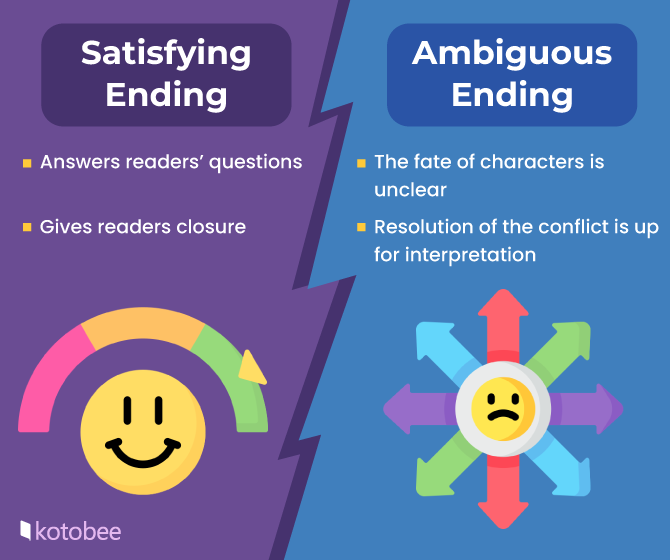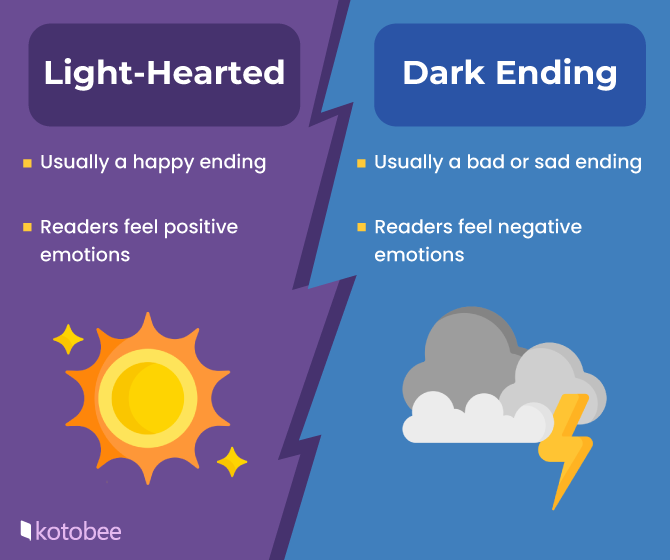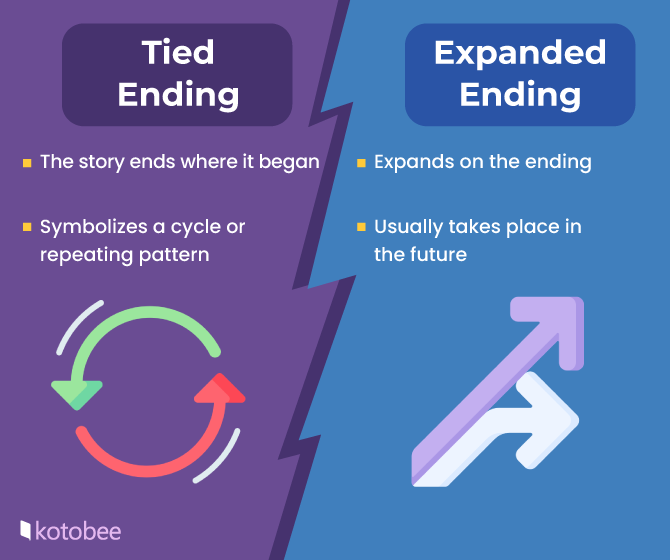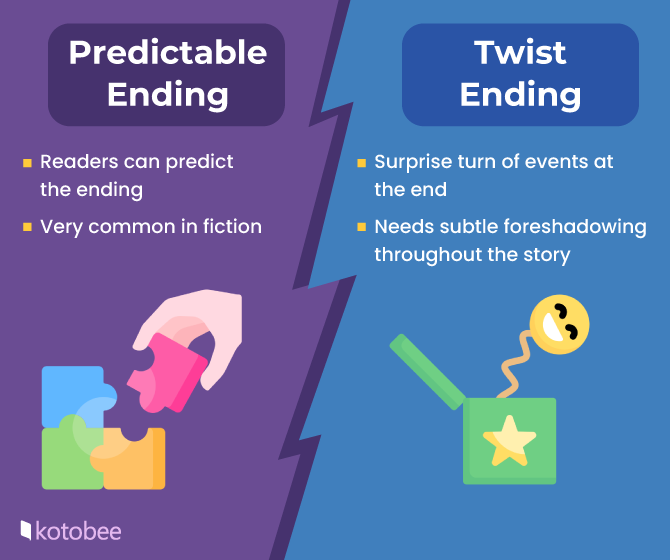When reading a story, you might feel excited about learning how it ends. You might even grow fond of the characters and want to see how the resolution of the story’s conflict will affect them. Maybe you’ll also find a well-crafted plot twist that shakes up everything you knew about a certain character!
As an author, however, coming up with a great ending for your story can be challenging. But don’t worry! It doesn’t have to be a bitter process. In fact, it can be an enjoyable and fulfilling experience.
In this article, we’ll show you how to end a story, along with examples from best-selling authors to illustrate various approaches to story endings.
Four Ways to End a Story
When deciding how to end your story, you should consider how your readers might feel after they close your book. That’s because each type of conclusion serves a different purpose, whether it’s satisfying, ambiguous, light-hearted, or dark. So, let’s explore how these choices affect the way your story resonates with your audience.
1. Satisfying vs Ambiguous Ending
A satisfying ending answers most, if not all of the reader’s questions and leaves them content with the conclusion of your story. When you present a clear ending, you show them the resolution of the conflict and how the characters live on afterward. This can help them feel that the story is finally complete.
An ambiguous ending, on the other hand, leaves readers asking questions about the conflict or its aftermath. In turn, they are left wondering what happened to the characters after the events of the story. For example, you can leave it up to the readers’ interpretation whether or not the main character survives at the end. This is a good way to make your book more memorable and encourage readers to think about its themes.

2. Light-Hearted vs Dark Ending
Concluding a story with light-hearted final chapters can be a great way to leave readers with a bright and uplifting tone. For example, the heroes manage to return home victorious from the final battle, or the love interest wins their beloved’s heart. Most of the time, these endings give readers a sense of happiness and cheerfulness.
On the opposite end of the spectrum, we have dark endings that are usually associated with tragic and terrifying stories. A dark ending can emphasize the themes of the story and add depth to character arcs. Think of beloved characters dying, or perhaps the villain winning against the heroes.

3. Tied vs Expanded Ending
A tied ending occurs when the story concludes in the same place or time of its beginning. For example, the characters may return to the park that they visited in the first chapter. Alternatively, the timeline might circle back to the events of the first scene, but this time they are narrated from a different perspective or by a different character. This ending adds a sense of poetic justice to the story and leaves readers thinking about the meaning behind it.
The opposite of a tied ending is an expanded one, otherwise known as an epilogue. Expanded endings combine a regular “final chapter” with an extra scene afterward that usually takes place in the future. You can use this ending type to provide closure to your readers and wrap up any leftover loose ends in the story.

4. Predictable vs Twist Ending
A predictable ending is one where readers can easily guess the resolution of the conflict. Though they don’t sound as appealing as unexpected ones, predictable endings are still a very popular choice for many authors. After all, readers like to feel smart and come up with their own ideas about the ending. Besides that, a predictable ending can be used to prove a point related to the story’s themes, especially in literary fiction.
Twist endings are also an option to consider. When you build up to a good twist, it can catch readers off-guard and delight them. However, be careful! If you end your book on a cliffhanger, many of your readers might feel frustrated.
To write a compelling twist ending, make sure to foreshadow it just enough throughout the rest of your story without spoiling the ending. Also, remember that you should only write a twist ending if it genuinely enhances your story. There’s no need to shock your readers just for the sake of it.

How to Properly End Your Story
Now that you’ve chosen your preferred ending type, let’s move on to the core of the article: how to write it! Every story will have its own unique ending, so you have the freedom to experiment with the guidelines below. Almost all stories adhere to them, so make sure to check your final chapter to see if your story does so as well.
1. Convey the Themes of Your Story Through the Ending
Themes are the underlying ideas, messages, or concepts that you are writing about in your story. They exist to add weight and meaning to the events of the plot and the characters’ development. However, even experienced authors might not fully integrate these themes into the ending, which can reduce the emotional impact of the final chapter.
For that reason, many readers tend to complain that the ending spoiled an otherwise brilliant book for them. To avoid this, make sure that the tone and events of the ending align with the themes of the book.
Let’s say that you’re writing a mystery/thriller about a long rivalry between a detective and a criminal, who murdered the former’s wife. The theme you choose might be the relationship between a person and their past. In the ending, you can reflect that theme in two ways.
In the first scenario, the detective has a hard time letting go of his wife and obsesses over the criminal instead of solving other cases. This distracts him from other murders committed by the same criminal and can even lead to a demotion from the police force.
In the second scenario, your detective might be able to accept his wife’s death and keep tabs on the criminal’s activities. As he does so, he uncovers patterns in the criminal’s activities or targets, which allows him to predict their plans and catch them in the act. At the same time, he begins to learn from his past rather than remain stuck in it, which helps him grow as a character.
2. Tie Up All (or Almost All) of the Loose Ends
Your final chapter has to wrap up the main conflict. This allows readers to feel a sense of closure and reflect on the story as a whole. It’s also just as important to resolve any loose ends in the plot, which might leave readers with unanswered questions and a feeling that the story is incomplete.
For example, one of your characters might have been going through their own side story. If you haven’t already done so, you have to resolve this subplot before you type “The End.”
There are only two exceptions to this rule: writing a sequel and using an ambiguous ending for your story. If you’re planning to write a sequel, then it’s fine to leave a few mysteries unsolved in the first story. With ambiguous endings, you’re naturally leaving some parts of the story up for readers to interpret.
3. Add an Element of Realism to Your Ending
Not many people like perfect “happily-ever-after” endings these days. On the contrary, they find tragic or bittersweet endings more realistic. Therefore, it’s a good idea to take these preferences into consideration so you can make your story ending as impactful as possible.
But how can you make your story ending more realistic? Well, there are various methods, each suited for certain genres or moods. Below are a few of these methods:
- The character(s) fail to achieve some of the goals they had. For example, they want to defeat an evil king, but the king escapes and goes into hiding.
- The character(s) loses something or someone they love. Perhaps the king kills the hero’s friends or destroys their homes.
- The character(s) choices and actions have unexpected side effects. What if, by failing to kill the king, the heroes indirectly cause the king’s knights to invade their homes and destroy them?
- The character(s) achieve their goals, but the results aren’t what they expected. Maybe the heroes do succeed in killing the evil king, but his successor turns out to be crueler and more sadistic.
Mistakes to Avoid in Your Story Ending
As you probably know, writing a great end to your story can be a tiring and difficult task. As a result, it’s easy to fall into certain traps that might reduce your audience’s enjoyment of the story as a whole.
Nevertheless, you can easily fix those mistakes as long as you are able to spot them. To help you do that, we’ve compiled a list of the most common mistakes you might make while writing your ending.
1. Ending the Story Suddenly or in the Middle of the Conflict
Have you ever been immersed in a story only for it to end right in the middle of the rising action? Unfortunately, quite a few authors end their stories mid-action because it can be difficult to figure out the best place to end it.
Thankfully, you can avoid making this mistake by having a story outline. Most stories follow the three-act structure, where a story is split into a beginning, middle, and end. To figure out the best place to finish your story, you should understand how the beginning, middle, and end are connected to one another.
You can ask yourself these questions to determine where you should end your story:
- Will the main conflict be resolved if the story ends here?
- Are there any important plot events that still need to happen after this point?
- Will readers feel that the ending is rushed or sudden if the story stops here?
Once you have answers to these questions, you can pinpoint the best place to end your story.
2. Using a Cliffhanger in a Standalone Novel
A cliffhanger is an ending in which you stop a scene right before a dramatic event. This creates suspense and excitement because readers want to know what happens next. Unfortunately, it can also make them angry and frustrated that they didn’t receive a proper book ending.
To avoid this, only add a cliffhanger ending to a book if you are writing a sequel. If not, then opt for a satisfying ending that wraps up the story.
3. Doing a Twist Ending Without Any Warning
Surprise endings happen when you add a plot twist to the end of your story. However, it’s difficult to write them in a way that readers will find believable. So, you have to set up the story so that the twist is surprising but convincing.
The best way to do this is by subtly foreshadowing the surprise throughout the story. Give readers enough hints so they keep guessing, but not enough that they can easily predict the ending.
One way to ensure you didn’t spoil the ending too early is by having beta readers review your story. They will tell you whether they were able to predict the ending or if they think it could have used a bit more foreshadowing.
4. Planning the Ending After You Start Writing Your Draft
Even if you write as you go without an outline, it’s a good idea to have the end of your story planned out in your mind. When you know how it ends from the start, you can set up the beginning and middle of the story accordingly. Otherwise, the ending might feel disconnected or unconvincing compared to the rest of the book.
In other words, don’t write yourself into a corner! Make sure to leave enough room in the story to build up to the ending. If you don’t want to build a detailed outline, it will help if you at least have some notes or mind maps handy.
5. Using Vague or Unclear Narration of What Happens in the Ending
Writing an ambiguous ending is different from writing unclear sentences. As we’ve mentioned before, an ambiguous ending still requires you to write clear events or actions that readers can follow. Otherwise, they will feel confused as to what exactly is going on in your story.
Let’s take an example of a paranormal mystery book. The plot goes like this: a college student suddenly collapses in the middle of her presentation. This sparks an investigation, but the student doesn’t have any health problems. Despite that, they experience several fainting episodes after that, which leads other students to think that a paranormal being is trying to possess the main character.
You want to end this story ambiguously and encourage readers to theorize about it. So, you can write a scene such as the one below:
Let’s say the main character faints one more time in the climax of the story and doesn’t wake up this time. The final scene can include the student in a hospital bed, surrounded by loved ones and doctors. There might be two police officers standing outside the room, discussing this new, unexplained case. However, the cause of these fainting spells is never uncovered, and the book ends there.
Notice how the scene is narrated in detail. The real point of ambiguity comes from the reason behind the student’s fainting not being revealed. In addition, readers might start wondering if this student will wake up again, and if they are the only target.
Examples of Great Story Endings
Whether or not readers like the end of a story is a matter of personal preference. However, there are several examples of great stories whose endings have delighted their readers and left lasting impressions on them. Here are a few of these endings!
1. Jane Austen’s Pride and Prejudice
Jane Austen’s novels always entail romance winning out over all obstacles, and Pride and Prejudice is no different. In this novel, both of the lead characters eventually marry and live together happily after, overcoming their pride and prejudices.
The protagonist, Elizabeth Bennet, initially makes a shallow, negative judgment of Mr. Darcy’s character based on first impressions. This is because Mr. Darcy himself starts out as a prideful character who looks down on people of lesser status. Still, over the course of the novel, Mr. Darcy humbles himself, and Elizabeth’s prejudices about him dissolve. By the end of the book, they have come to respect one another as lovers.
Austen wraps up Pride and Prejudice with a happy, satisfying ending that resolves the conflict within the characters and between their families. The ending is simple, but it reflects Elizabeth and Mr. Darcy’s character arcs as well as the themes of the book.
Type of ending used: A light-hearted, satisfying ending.
2. Arthur Miller’s All My Sons
Arthur Miller’s play, All My Sons, centers around family secrets and corruption. Therefore, the ending of the play is dark and inevitably exposes the truth to the characters and the audience.
The play centers around two families, the Kellers and Deevers. Joe Keller and Steve Deever are fathers and former business partners. However, one fateful decision to export faulty plane parts results in Steve going to jail for Joe’s crime. Three years before the play starts, Joe’s son Larry finds out about the crime and deliberately crashes his warplane to kill himself out of shame. This truth is dramatically revealed in the final act through a letter that Larry wrote before committing suicide.
All My Sons centers on the themes of idealism, corruption, and revealing the truth no matter the consequences. So, its chaotic ending resolves the conflict in the same way it began: with the death of a Keller family member. At the same time, Chris’ mother, Kate, tells him to go live his life and marry his fiance. In other words, Chris Keller’s fate after the play is left up to the audience’s imagination.
Type of ending used: A dark ending that is somewhat ambiguous and includes a surprise event.
3. Roald Dahl’s Matilda
Finally, Roald Dahl’s Matilda ends on a cheerful and hopeful note. After dealing with neglectful and abusive parents, Matilda finally finds a safe environment with her teacher, Miss Honey, to grow up and learn. She’s achieved justice for herself and her teacher, who later adopts her.
At first, Matilda has to sneak away from her parents in order to read books from the library. At school, she faces a new obstacle in the form of the school headmistress, Miss Trunchbull. She also happens to be the abusive and greedy aunt of Matilda’s favorite teacher, Miss Honey. Not only did Miss Trunchbull treat children horribly at school, but she also stole her niece’s inheritance and forced her to live in poverty.
The ending of the book resolves both Matilda’s and Miss Honey’s struggles with her aunt by permanently removing their abusive relatives. It’s a happy ending for both of them as Miss Honey adopts Matilda and moves her to an advanced class. This way, she can finally experience the familial love she was deprived of and Miss Honey can take back the inheritance her aunt withheld from her.
Type of ending used: A light-hearted, satisfying ending with a small twist.
Final Thoughts
It can be hard to end a story you’ve poured so much love and creativity into. But, the process of writing a compelling story conclusion can be more straightforward than you might think. Take your time and make sure the ending of your story captivates your readers just as much as the rest of it!
If you’ve done it before, we’d love to hear your own experiences with writing story endings. So, feel free to tell us all about it in the comments section below.
.
Read More
What is Conflict in a Story and How to Write One in 8 Steps
Elements of Fiction: A Quick Guide to Writing the Perfect Story

